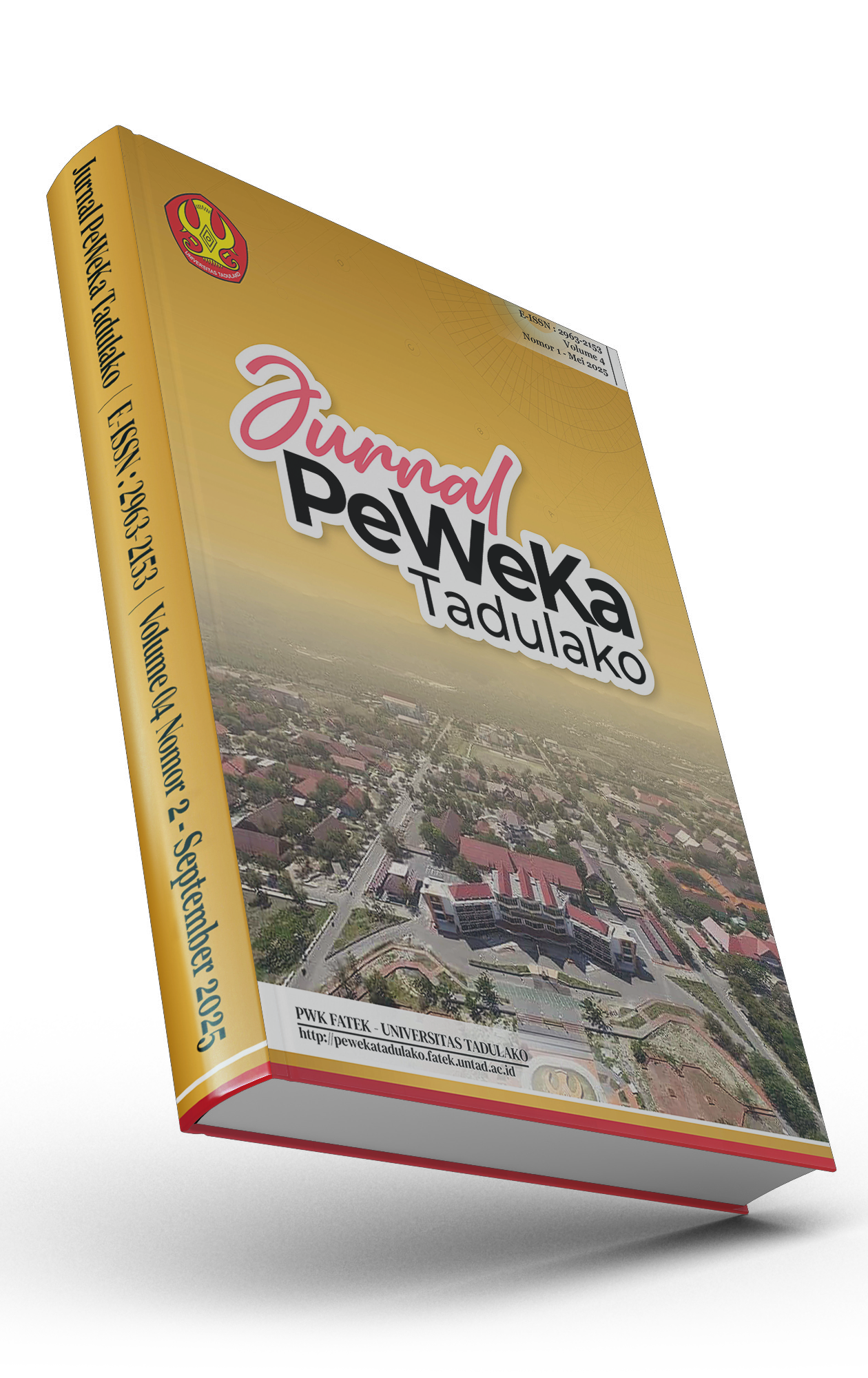Studi Komparatif Keterikatan Tempat (Place Attachment) pada Komunitas Relokasi dan In-Situ Pascabencana Likuifaksi di Sulawesi Tengah
DOI:
https://doi.org/10.22487/peweka.v4i2.77Keywords:
Post-Disaster, Housing Reconstruction, Place Attachment, Relocation, In-situAbstract
Post-disaster housing reconstruction is a crucial stage that often focuses on physical recovery, while the restoration of the emotional connection between people and their homes is frequently overlooked. This raises an urgent need to understand how reconstruction policies affect the human dimension of survivors. Therefore, this study aims to comparatively analyze the impact of two reconstruction schemes, relocation to permanent housing (Huntap) and in-situ stimulant funds, on the recovery of place attachment among the survivor community of Dusun III Vou, Central Sulawesi. This research is using a qualitative method with a comparative case study design, data were collected through in-depth interviews and field observations. The findings indicate that the two approaches yield fundamentally different consequences. The relocation scheme succeeded in providing physical security from environmental trauma but significantly severed the community's functional ties to their agrarian livelihoods. Conversely, the in-situ scheme successfully maintained socio-economic continuity and social cohesion, although survivors must live with place-based trauma. This study concludes that the choice of reconstruction policy represents a dilemma between recovering physical security and ensuring socio-economic sustainability, implying the need for more holistic recovery models in the future.
References
Amiruddin, A., & Lumbaa, Y. (2024). Kehancuran dan Harapan Baru: Gempa, Tsunami dan Likuifaksi di Palu Sulawesi Tengah 2018. TUTURAN: Jurnal Ilmu Komunikasi, Sosial dan Humaniora, 2(3), 252-259.
Bahri, S. (2024). Transmisi Informasi Kebencanaan Dalam Penerapan Kebijakan Relokasi Pasca Gempa Bumi, Tsunami Dan Likuifaksi Di Palu Sulawesi Tengah: Transmission Of Disaster Information In Implementing Relocation Policies After The Earthquake, Tsunami And Liquefaction In Palu, Central Of Sulawesi. Journal of Government Science (GovSci): Jurnal Ilmu Pemerintahan, 5(2), 79-99.
Bartlett, L., & Vavrus, F. (2017). Comparative Case Studies. Educação & Realidade, 42, 899-920. https://doi.org/10.1590/2175-623668636.
Boley, B. B., Strzelecka, M., Yeager, E. P., Ribeiro, M. A., Aleshinloye, K. D., Woosnam, K. M., & Mimbs, B. P. (2021). Measuring place attachment with the Abbreviated Place attachment Scale (APAS). Journal of Environmental Psychology, 74, 101577. https://doi.org/https://doi.org/10.1016/j.jenvp.2021.101577
Elintia, E., Widodo, P., Saragih, H., & Kusuma, K. (2024). Rehabilitation and Reconstruction Post-Earthquake, Tsunami and Liquefaction Disaster in Central Sulawesi Province. International Journal Of Humanities Education and Social Sciences (IJHESS), 4. https://doi.org/10.55227/ijhess.v4i1.1201
Guzal-Dec, D. J., & Zwolińska-Ligaj, M. A. (2023). How to Deal with Crisis? Place attachment as a Factor of Resilience of Urban–Rural Communes in Poland during the COVID-19 Pandemic. Sustainability, 15(7), 6222. https://www.mdpi.com/2071-1050/15/7/6222.
Husain, S. (2022). Peran Japan International Cooperation Agency (Jica) Pasca Bencana Alam 2018 Di Sulawesi Tengah. Spektrum, 19(2), 1-16. https://doi.org/10.31942/spektrum.v19i2.6660.
Hutabarat, L. E., Simanjuntak, P., & Tampubolon, S. P. (2019). Peningkatan kesadaran masyarakat terhadap kerusakan bangunan dan lingkungan pasca gempa, tsunami dan likuifaksi di Palu Sulawesi Tengah. Jurnal Comunita Servizio, 1(2), 208-222.
Iskandar, I., Taufiqurokhman, T., & Satispi, E. (2024). Peran Lembaga Kesejahteraan Sosial Anak (LKSA) Pascabencana Gempa Bumi : Studi Pada LKSA Budi Luhur Kabupaten Cianjur. Jurnal ISO: Jurnal Ilmu Sosial, Politik dan Humaniora, 4(1). https://doi.org/10.53697/iso.v4i1.1740.
Iswari, M. F. (2020). Kegawatdaruratan Psikologis Berupa Tingkat Stres, Kecemasan dan Depresi Korban Gempa, Tsunami dan Likuifaksi di Wilayah Pantoloan Kabupaten Donggala Palu Sulawesi Tengah. Master Medika, 8(1), 46-52. https://doi.org/10.52523/maskermedika.v8i1.377.
Ophiyandri, T. (2011). Community‐Based Post‐Disaster Housing Reconstruction: Examples from Indonesia. Post‐Disaster Reconstruction of the Built Environment: Rebuilding for Resilience, 91-116.
Ophiyandri, T., Amaratunga, P., Pathirage, C., & Keraminiyage, K. (2013). Critical success factors for community-based post-disaster housing reconstruction project (CPHRP) in pre-construction stage in Indonesia. International Journal of Disaster Resilience in the Built Environment, 4. https://doi.org/10.1108/IJDRBE-03-2013-0005.
Qing, C., Guo, S., Deng, X., Wang, W., Song, J., & Xu, D. (2022). Stay in Risk Area: Place attachment, Efficacy Beliefs and Risk Coping. International Journal of Environmental Research and Public Health, 19(4), 2375. https://www.mdpi.com/1660-4601/19/4/2375.
Samad, A., Erdiansyah, & Wulandari, R. (2020). Evaluasi Kebijakan Pemerintah Pasca Bencana (Studi Kasus Bencana di Sulawesi Tengah). Publik (Jurnal Ilmu Administrasi), 9(1), 15-24. https://doi.org/10.52523/maskermedika.v8i1.377.
Sembiring, N. W., Manurung, R., & Aulia, D. N. (2016). Makna Rumah Tinggal Bagi Penghuni Dan Implementasinya Pada Perumahan Terencana Di Kota Medan. Prosiding Seminar Kearifan Lokal dan Lingkungan Binaan, 378-392. https://seminararsitekturlingkunganbinaan.wordpress.com/wp-content/uploads/2018/08/prosiding-seminar-nasional-lingkungan-binaan-2016.pdf
Setiawan, T., Riasnugrahani, M., & de Jong, E. (2023). Psychometric properties of Indonesian slums dwellers’ place attachment. Heliyon, 9(9), e19704. https://doi.org/https://doi.org/10.1016/j.heliyon.2023.e19704.
Surtiari, G. A. K. (2019). Pentingnya penanganan pascabencana yang berfokus pada penduduk untuk mewujudkan build back better: pembelajaran dari bencana Palu, Sigi, dan Donggala. Jurnal Kependudukan Indonesia, 14(2), 165-184.
Wang, Z., Han, Z., Liu, L., & Yu, S. (2021). Place attachment and Household Disaster Preparedness: Examining the Mediation Role of Self-Efficacy. International Journal of Environmental Research and Public Health, 18(11), 5565. https://www.mdpi.com/1660-4601/18/11/5565.
Williams, D., & Vaske, J. (2003). The Measurement of Place attachment: Validity and Generalizability of a Psychometric Approach. Forest Science, 49, 830-840. https://doi.org/10.1093/forestscience/49.6.830.
Yin, R. K. (2018). Case Study Research Design and Application: Design and Methods (Sixth Edition). SAGE Publications.
Downloads
Published
How to Cite
Issue
Section
License
Copyright (c) 2025 Adnagmesha Magfirah Ramadhani Najib, Bakti Setiawan

This work is licensed under a Creative Commons Attribution-ShareAlike 4.0 International License.







